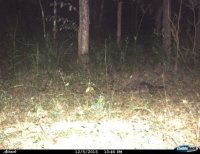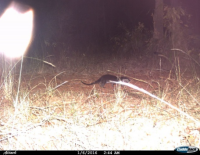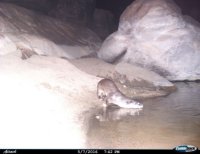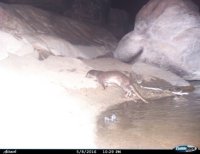IUCN/SSC Otter Specialist Group Bulletin

|
©IUCN/SCC Otter Specialist Group
Volume 33 Issue 2 (October 2016) Citation: Jena, J, Bhargava, D, Borah, J and Dey, S (2016). Notes on the Occurrence of the Eurasian Otter (Lutra lutra L.) in the Forest of Balaghat, Madhya Pradesh, India . IUCN Otter Spec. Group Bull. 33 (2): 59 - 63 Notes on the Occurrence of the Eurasian Otter (Lutra lutra L.) in the Forest of Balaghat, Madhya Pradesh, India Jyotirmay Jena1, Dhirendra Bhargava2 , Jimmy Borah3 and Soumen Dey1
1WWF-India, Satpuda Maikal Landscape Programme,
Jabalpur-482020, Madhya Pradesh, India
Email: bapinou@gmail.com |




|
| (Received 8th March 2016, accepted 2nd September 2016) |
| Abstract: Eurasian otter presence was recorded in Balaghat forest range of Madhya Pradesh while conducting camera trapping study for large carnivores. The species shows a wide spread distribution from Europe, Nepal, Sri Lanka, Northern Africa, South East Asia. Though Eurasian otters have been recorded from Northern and Southern India, this is the first ever photo capture of Eurasian otter from Balaghat Forest Circle of Madhya Pradesh state in Central India |
| Keywords: Lutra lutra, Eurasian otter, ecosystem, distribution, central India |
| Française | Español |
Otters play an important role in the aquatic ecosystem as top carnivores and thus influence the function of the ecosystem. Often considered as an indicator species of the fresh water ecosystem or fluvial ecosystem, they provide indication of the overall health of the aquatic ecosystem. Globally, the Eurasian otter is distributed starting from Europe, south-east Asia, India, Nepal, Russia, China, Myanmar, Thailand, Indonesia, Malaysia, Taiwan and also some parts of Africa (Roos et al., 2015).
In India, the Eurasian otter is distributed from the foothills of Himalayas (Kashmir, Himachal Pradesh) to Sikkim and Assam in northeast of India (Prater, 1948; Hussain, 1999). The species is also recorded from Southern India. Though otter presence in Balaghat dates back to 1907 (Low, 1907) as mentioned in the district gazetteer, it remained un-noticed to the scientific community.
Though Eurasian otter is found in variety of habitat such as lakes, rivers, streams, rivers, swamps, coastal area and estuaries their distribution in India was recorded only in the above mentioned area. Also very little is known about the status of their populations from the country. It is believed that there has been a rapid decline due to loss of habitat and poaching for meat, pelt and pet (Hussain, 2002; Mohapatra et al., 2014). In this article we report presence of Eurasian otter from Balaghat forest circle of Madhya Pradesh state of India, which is also the first photographic evidence from the area.
The Balaghat Forest Circle is one of the intact and contiguous forest patches in Central Indian Landscape and important part of Kanha-Pench tiger conservation unit. The forest of Balaghat circle is connected to three protected areas namely Kanha, Pench, Navegaon-Nagzira tiger reserve and facilitate dispersal of tigers. Hence the area is very much important in terms of landscape level conservation. However the conservation focus of the landscape has been around some of the charismatic species such as tiger (Panthera tigris). But the landscape supports a wide array of faunal and floral diversity. Though the faunal assemblage of protected areas are well understood, very little is known about other wildlife beyond the protected areas, in forests such as Balaghat. Otters historically have been recorded in the large river of the landscape such as Narmada and from Kanha Tiger Reserve (personal communication with Forest Officers). However, presence of otters beyond the protected area is little understood or documented. During our recent camera trapping study for large carnivore in Balaghat, we photo captured otters in several areas of the Balaghat forest circle (Fig. 1).
Following the photo capture of the otter from the forest of Balaghat, we tried to collect information about their presence from local community. The local fishermen confirmed the presence of otter in the Dhutti dam of river Wainganga. The second author had direct sighting of otters (one occasion) after subsequent visit to the dam. (Fig. 2). Also further camera trapping from the dam site resulted into successful photo capture of the otter (Table 1). Though Balaghat forests support good number of wildlife populations, this is the first ever photographic record of Eurasian otter from this forest as well the occurrence is reported for the first time.
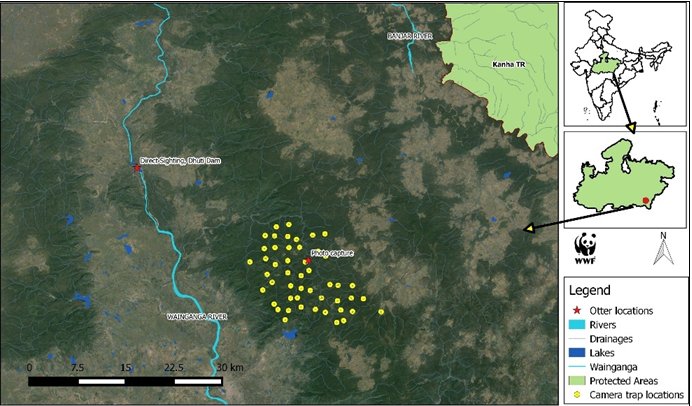
|
| Figure 2. Map showing Eurasian otter photo capture and direct sighting location from Balaghat, Madhya Pradesh, India (click for larger version) |
The Eurasian otter has been listed in Appendix I of CITES and Near threatened as per IUCN Red List, due to decline in population. In many areas the information on distribution as well population status is lacking.
The recent ongoing survey in Balaghat presently only covers approximately 820 sq. km. The forest type varies from Sal dominated forest to miscellaneous forest, and numerous annual and perennial streams crossing over the area. A large chunk of the study area is still remote and the anthropogenic pressure is comparatively less. The presence of otters in the Balaghat forest requires more extensive studies in terms of population and habitat use. As a territorial forest division area with relatively lesser protection regime compared to the protected areas in central India, Balaghat would require more intensive policy based actions, research on factors affecting its survival and awareness campaigns among communities for the long term survival of the species.
Acknowledgements: The authors are grateful to the Principal Chief Conservation of Forest (Wildlife) Madhya Pradesh for permitting us to work in Balaghat Forest Division. We also thank Dr. S.A. Hussain and Dr. Nicole Duplaix for their expert suggestion in identification of the species. We are grateful to the field staff of WWF-India, SML team particularly to Mr. Avinash Dubey for his immense contribution to regular monitoring of camera traps. Also the authors are grateful to Dr. Dipankar Ghoshe, Director Species Programme, WWF-India for his continuous encouragement. We would like to thanks WWF-UK and WWF-Sweden for funding the entire study in Balaghat.
REFERENCES
Foster-Turley, P., Santiapillai, C. (1990). Action plan for Asian otters, In Pat Foster-Turley, Sheila Macdonald and Chris Mason (Eds.) Otters, an action plans for their conservation. IUCN/SSC, Otter Specialist Group. IUCN, Gland. 126 pp.
Hussain, S.A. (1999). Species profile: Mustelids, Viverrids and Herpestids of India. ENVIS Bulletin on Wildlife & Protected Areas. Wildlife Institute of India. 2 (2): 1-38.
Hussain, S.A. (2002). Conservation status of otters in the Tarai and Lower Himalayas of Uttar Pradesh, India. In Otter Conservation-An example for a sustainable use of wetlands. Proceedings from VIIth International Colloquium, Trebon, Czech Republic, 2002. IUCN Otter Specialist Group Bulletin: 19A: 131-142.
Low, C. E. (1907). Central Provinces District Gazetteers: Balaghat District. Volume A, Descriptive, 36 pp.
Mohapatra, P., Palei, S. H., Hussain S. A. (2014). Occurrence of Asian small-clawed otter Aonyx cinereus (Illiger, 1815) in Eastern India.Current Science. 107(3): 367-370.
Prater, S.H. (1948). The book of Indian animals. Second edition. Oxford University Press, Delhi. 324 pp.
Roos, A., Loy, A., de Silva, P., Hajkova, P., Zemanová, B. (2015). Lutra lutra. The IUCN Red List of Threatened Species 2015: e.T12419A21935287
[http://dx.doi.org/10.2305/IUCN.UK.2015-2.RLTS.T12419A21935287.en. Downloaded on 19 August 2016]
The Wild Life (Protection) Act, 1972 (As amended upto 2006) (2008). TRAFFIC India, WWF-India, New Delhi. Natraj Publishers, Dehradun.
Résumé :
Indices sur la Présence de la Loutre Eurasienne (Lutra lutra L.) dans la Forêt de Balaghat, Madhya Pradesh, Inde
Les loutres ne sont pas territoriales au sens classique du mas dans leur habitat peut
être utile à des fins d’activités de loisirs, ou plus largement pour gérer les
conflits faune sauvage/humains.
Revenez au dessus
Resumen: Notas sobre la Ocurrencia de la Nutria Euroasiática (Lutra lutra L.) en el Bosque de Balaghat, Madhya Pradesh, India
Registramos la presencia de la nutria en la zona del bosque de Balaghat, en Madhya Pradesh, mientras conducíamos un estudio de carnívoros con cámaras-trampa. La especie exhibe una amplia distribución en Europa, Nepal, Sri Lanka, Norte de Africa y el Sudeste de Asia. Aunque se han registrado nutrias euroasiáticas en el Norte y el Sur de la India, esta es la primera captura fotográfica de la especie en el Anillo Forestal Balaghat, estado de Madhya Pradesh, India Central..
Vuelva a la tapa
